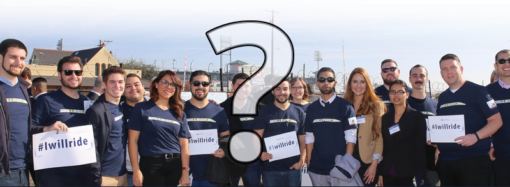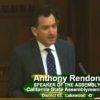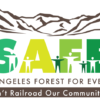As previously reported the Los Angeles Times uncovered a report that divulged increasing costs were a real possibility for California’s High-Speed Rail Project.
After the Times article there was a chain reaction demanding the public disclosure of the report the LA Times exposed. Both California and Federal legislators were asking that the Authority turn over the goods. Congressman Jeff Denham wants to know who knew about the content of this report and he and other Congress representatives sent Parsons Brinckerhoff a request to get the facts.
Part II Tos/Fukuda/Kings County Lawsuit
The report was even the subject of a court hearing in an upcoming lawsuit – Part II of the Tos/Fukuda/Kings County legal action. This case will be heard in February and will attempt to prove violations of the Prop 1A bond measure, questioning the financial viability of the entire project.
Project opponent’s attorneys came before Judge Michael Kenny on October 30th to ask him to review the 2013 Parson’s Brinckerhoff report, under seal, to see if it should be included in the High-Speed Rail Authority’s Administrative Record since it was clearly produced before the evidence cut off date. At first the Authority’s attorneys refused, asserting the report did not have to be disclosed under a narrow part of the public records act called the deliberative process privilege. The judge ordered them to come back to court November 23rd with the document and he would then determine if he needed to review it or not.
The Authority’s attorneys argued that the document was never provided to the Board and therefore was not considered in connection with the adoption of the 2014 Business Plan. Project opponents attorneys disagree. Rather, they believe the evidence shows the 2013 Parsons Brinckerhoff report (actually a presentation) was considered at the time they were preparing the Business plan and a decision was made by CHSRA staff to exclude it. The report itself was labeled as, “2014 Business Plan Capital Cost Update.” Opponent attorneys contend that rejection of that document does not mean it wasn’t considered and therefore belongs in the administrative record.
In an unexpected move, the Authority’s attorneys voluntarily agreed to include the report in their administrative record for the case.
Stuart Flashman, one of project opponent’s attorneys said this, “My personal feeling is that once they’d been pressured into releasing the document (holding it secret while claiming to be the most transparent agency around, even by CHSRA standards, laughable), they realized that there was no way they could keep it out of the record, and they’d just look bad, so they threw in the towel and agreed to put it in.”
See Californians Advocating Responsible Rail Design’s (CARRD) expose, the second document of the link, called 2015, November 9th Final which explains more about the lack of transparency of this HSR Board.
How will the PB document affect the case? Flashman says it will make the financial viability case stronger. In the opening brief filed on November 2, 2015, there is a section that discusses the gap in funding based on the 300-mile long initial operating segment. The brief says, “Whether the catch phrase, “If you build it, they will come,” is true or not, it is incontestable that if you can’t build it, they (the customers) will not come. A train system that cannot be built cannot be considered financially viable.”
The 2013 PB report will show a wider gap in the Authority’s financial ability to build the first segment since it was this segment in particular that rose from $31 billion to $40 billion. Note this first segment is more than the original estimated cost for the entire project.
Why was the report not sent to Authority leaders?
Let’s look at this situation. The Authority’s CEO Jeff Morales says he didn’t see the PB report and the board denies seeing the report. If you believe this scenario is possible, the question is who saw the report? Did more junior levels on the Authority’s staff have the right to deep six this report? What would be their motives?
There have been people who work for PB at VP levels and also sat in key decision making roles. They were called Deputy Directors. These were the exact titles of people who were in the position before them who were HSR employees. They don’t get salaries from the Rail Authority, they work for PB, it’s an outsourced relationship. PB pays their costs and the state doesn’t have to pay benefits and retirement for a permanent employee. It sounds like a good deal however the question is could their decisions be more bias toward the benefit of their parent company? Bent Flyvbjerg, mega project expert thinks so in his article, Delusion and Deception in Large Infrastructure Projects:
A manager on a large infrastructure project explained to Flyvbjerg and Cowi in their research on transport infrastructure management in the UK: “Most decent consultants will write off obviously bad projects, but there is a grey zone and I think many consultants in reality have an incentive to try to prolong the life of projects, which means to get them through the business case. It is in line with their need to make a profit.”
There are other senior level Authority employees who might have the hutzpah not to disclose a document to senior management which might make them look bad.
Who’s on the receiving end of the money right now?
The politicians talk about jobs, jobs, jobs and while there has been some planning jobs and few construction jobs as the Authority attempts to get something started in the Fresno area, most of the real money is being made by Parson Brinckerhoff (PB) and other consulting companies. The first construction company, Tutor Perini is not working in full building mode because the land needed to build the very first segment is not fully purchased yet.
PB won a $700 million dollar contract in June 2015 in a very narrow race. It was their second contract since they have been in charge of the program since the start and now have an extension until 2022. There are 100’s of people actively working on the project.
Bay Bridge vs. High-Speed Rail Project:
Remember Jeff Morales is a former VP of Parsons Brinckerhoff who was working on the project before he was named CEO of the HSR project. Jeff Morales has a history with big projects and has his fingerprints on the Bay Bridge project where he served as the director of Caltrans.
Regarding the Bay Bridge and Morales’ involvement, in a California Senate Report it says this, “April 2001: Caltrans tells Legislature the new cost is $1.462 billion more than the last estimate for a new total of $2.747 billion. Then Caltrans Director Jeff Morales says these are “high-end numbers.”
The Bay Bridge project then went on to be one of the most expensive in California’s history doubling Morales’ forecast. By the project’s completion the cost grew from its original estimate of $1.4 to 5.4 billion and counting principal and interest it will be $13 billion of public dollars spent according to Senator DeSaulnier’s Lessons Learned Hearing on the Bay Bridge. See this eloquent editorial on the aftermath of that project.
Bottom line, no one went to jail, no one was held responsible and in the end only the taxpayer was left holding the bag with increased toll charges. To top off the incredible construction costs, the project has had structural problems since its grand opening due to shoddy workmanship as discussed during Senator DeSaulnier’s Senate hearing on the Bay Bridge.
In comparison California’s High-Speed Rail project is poised to take over top honors in this same category. It has already doubled cost estimates first starting around $33 to now an unrealistic $68 billion. It must be noted that the draft 2012 Business Plan ranged in price from $98 to 117 billion, it was called the “honest plan,” and was the last piece of work authored by the former CEO Roelof van Ark before he disappeared from the scene. That draft plan lasted 5 months before the final 2012 business plan was published and the costs dropped to the current figure of $68 billion.
It seems unlikely, in three years since the $68 billion cost number first surfaced, that costs remain stagnant though major problems have surfaced such as subsidence, tunneling costs, rising property values etc. Revealed in PB’s 2013 presentation, the base numbers actually come from 2009 estimates making the 2014 Business Plan numbers seemingly impossible. How do they make the numbers stay the same? By cutting other cost estimates in the plan or what they now consider unnecessary costs.
In a November 5, 2015 article from capital public radio Dan Richard, Chairman of the Board said, “We should be held accountable for the numbers that we publish and say ‘we’re going to build it for this,'” says Richard. “If it starts to go awry, and they want to hang me out by my thumbs, or our CEO’s, that’s fine.”
In a 2014 editorial on the Bay Bridge just the same as noted by Debra Saunders for the Bay Bridge project consequences, there will be no punishment, no “thumb hanging,” for those not making budget or time tables for the High-Speed Rail project and we could hear a repeat of what Governor Brown observed when he was confronted with cost overruns information on the Bay Bridge, “S— Happens.”
Huge projects go way above costs on a regular basis because exactly no one is held accountable. Career politician, Willie Brown acknowledged that it is done deliberately in a July 27, 2013 SF gate article:
“In the world of civic projects, the first budget is really just a down payment. If people knew the real cost from the start, nothing would ever get approved. The idea is to get going. Start digging a hole and make it so big, there is no alternative to coming up with the money to fill it in.”
William Grindley, author of many financial reports on the California HSR project believes, “That statement perfectly describes not only the moral, if not legal, corruption of politicians and their cronies but the High-Speed Rail Authority’s strategy of ‘start building and they cannot stop us.”
History of Parsons Brinckeroff:
Parsons Brinckerhoff has its own special notoriety- the ‘Big Dig’ in Boston. It went off the charts in spending and delays in building. Apparently the cost estimate was $2.8 billion and when all the interest is included, it will have cost $24 billion according to this article.
There was a report written later in 2010 recounting a conversation between PB workers when things were going really badly on the Big Dig. PB worried about the very viability of the project. A transcript reveals this:
“Is there a strategy to back ourselves out of this job? Or are we just going to continue to suck on the cow as long as it lives?” the unidentified manager asked, according to the transcript.
“You suck on the cow as long as it’s alive,” another manager replied.
“Absolutely. You’ve got a thousand people on this job,” the first manager said, according to the transcript.
According to this report, “the exchange illustrates Bechtel/Parsons Brinckerhoff’s willingness to “put its own welfare and profit ahead of the interests of its client, the Commonwealth and the Turnpike Authority.”
So for now, the high-speed rail “cow” is on life support and the Rail Authority continues to squander planning funds and precious cap-and-trade dollars meant for projects that will save the environmental pollution. It is clear that this spending will not end as was promised to the public, that is, a high-speed rail system.
According to Chairman Dan Richard, even if the worst case scenario happens and you don’t get high-speed rail with the appropriation voted for in July 2012, one of the things the state will get is the “acquisition of right-of-way that doesn’t exist today, in the fastest growing part of the state in the Central Valley for a system in the future.”
In the meantime, hundreds of landowners in the Central Valley are being strong-armed to give up their family homes, their heritage and their livelihood for what? A right of way for something that may never be.




